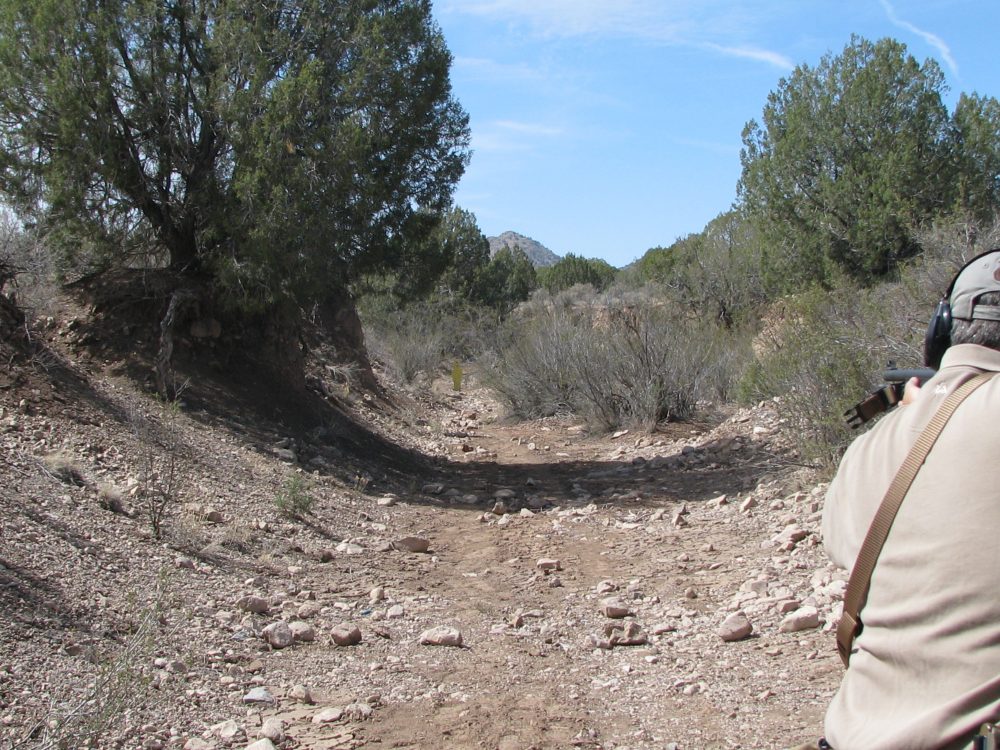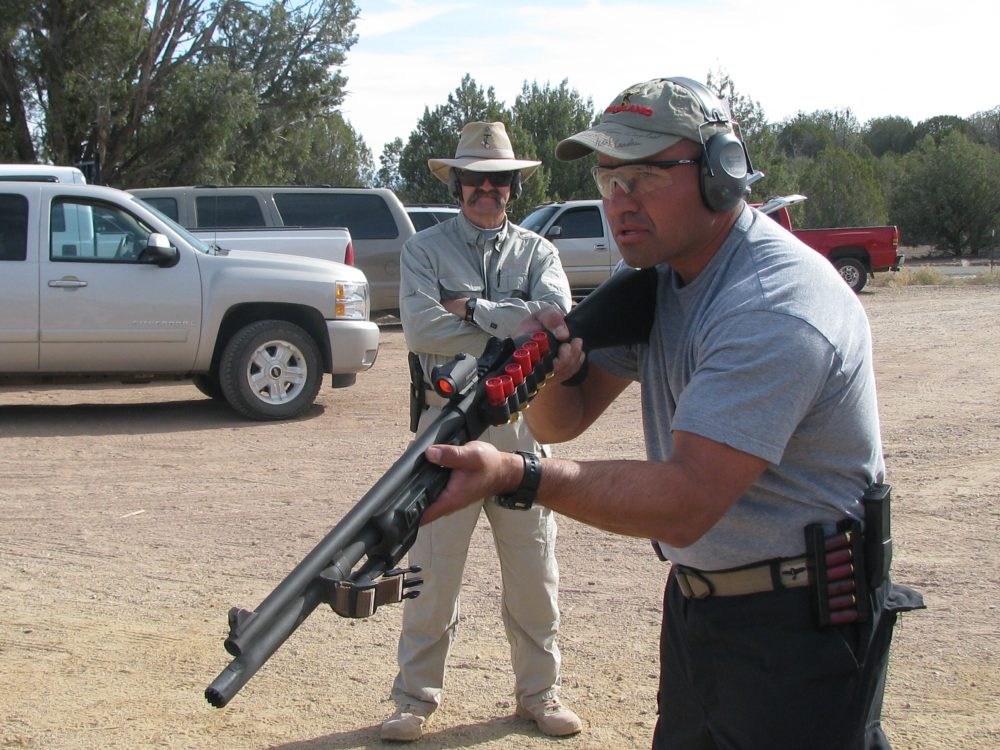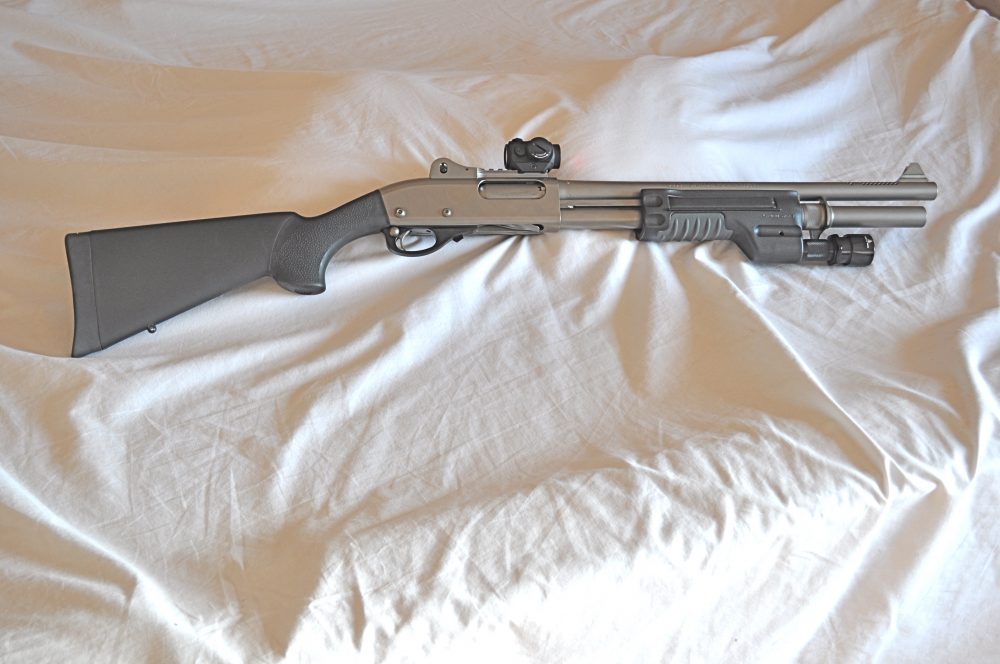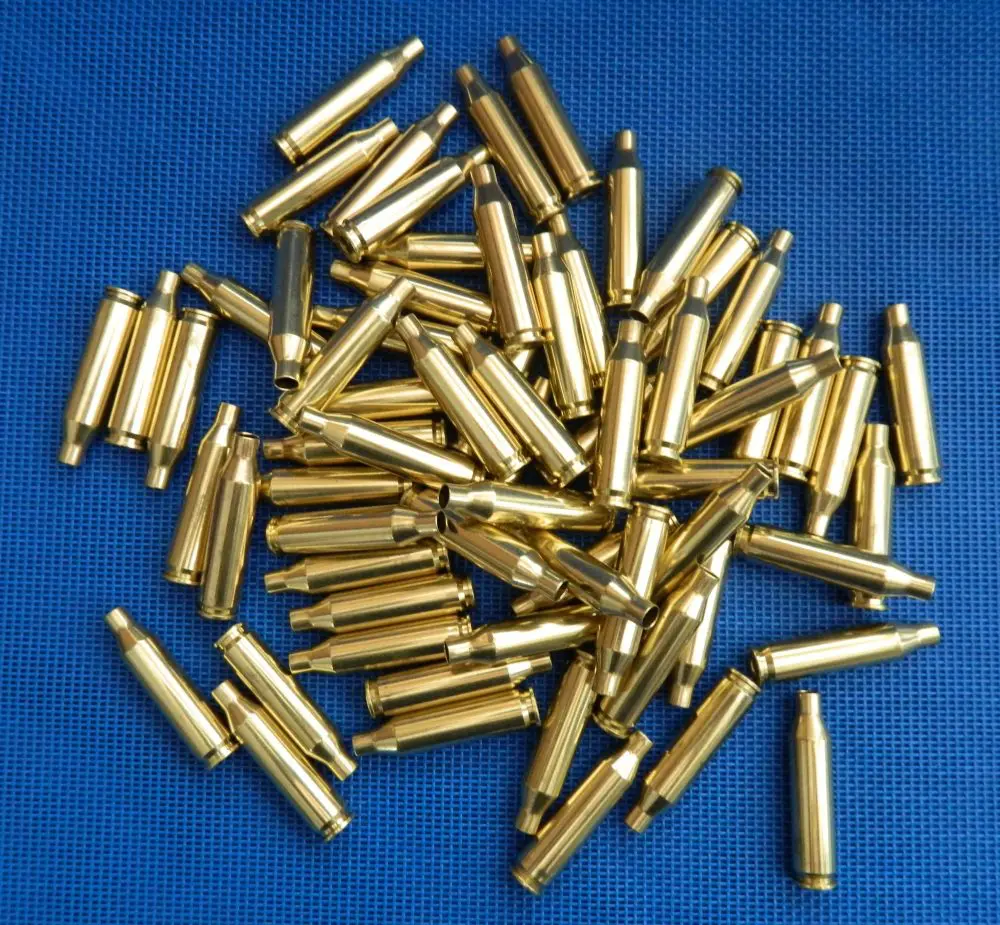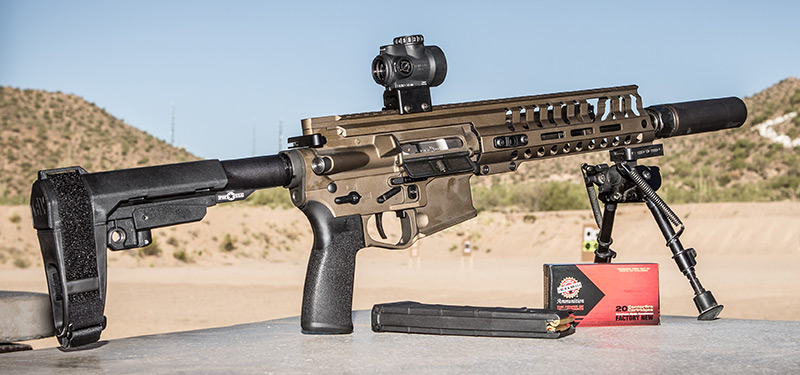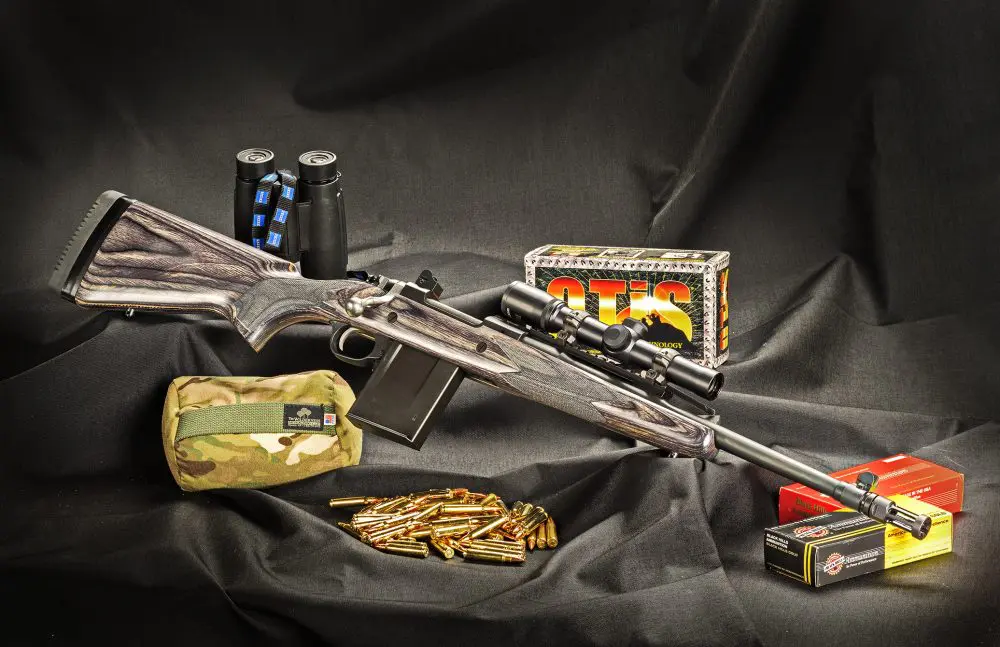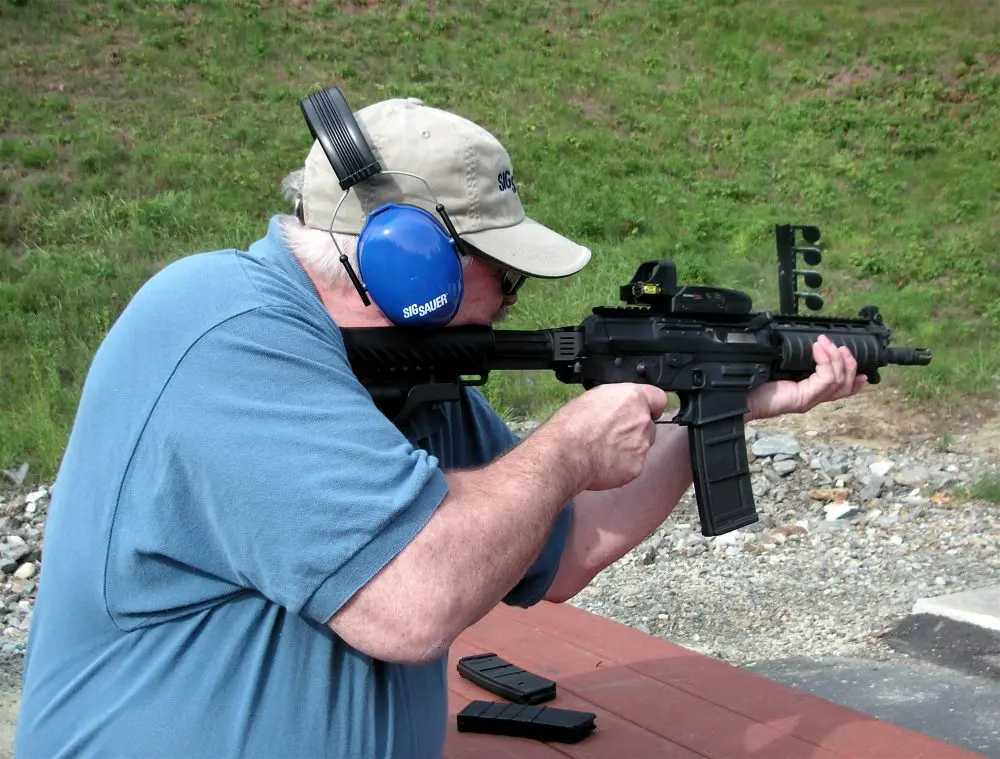Hans Vang lectures on shotgun modifications.
Shotguns have been used as combat weapons since the matchlock. The fighting shotgun reached a pinnacle in the “trench gun” of the early 20th century—an 18-inch barreled Model ’97 or Model 12 with a bayonet, spraying buckshot into groups of enemy soldiers at close range. United States soldiers used shotguns in World War II, Korea, Vietnam and they are still being used in the Middle East today.
Law enforcement embraced the shotgun early on. Doc Holliday used one at the OK Corral, and any photo of the Texas Rangers shows a Ranger or two with a shotgun. In the old days, the shotgun was considered an “area” weapon—point it downrange and shoot into an area.
Table of Contents
SHOTGUNS IN THE 21ST CENTURY
The shotgun of today is a far cry from those early guns, and the use of the shotgun has changed. Many departments have abandoned the shotgun, opting for the carbine only for cost savings and ease of training. In too many agencies, the shotgun has been relegated to an orange-painted, less-lethal delivery tool. In progressive departments it is used in its best mode—a viable fighting weapon.
Aimpoint’s Military Business Development Director, Freddie Blish, shooting on the move from the support-side shoulder.
The police shotgun should be issued to individual officers after solid training. The old concept of a gun in the rack, with the officer having no idea of its pattern or zero, is a disaster-in-waiting. The gun should be set up for the officer, including having the stock modified to fit the officer, zeroed and patterned for the ammo carried, and used at the officer’s discretion.
An urban myth is that the mere sound of a shotgun being racked will cause a felon to freeze. While it may get the attention of a bad guy, don’t think he’s going to quit just because you chamber a round. You have to be able to use it effectively once it’s deployed.
Bill Murphy, Gunsite rangemaster and working SWAT officer, says, “The shotgun is a thinking man’s weapon. It is the only gun in the officer’s arsenal that can load mission-specific munitions. It can deliver instant stopping energy from one to 100 yards.” The loads include birdshot, buckshot, breaching, slugs, shell cracker (noise), gas, less-lethal, aerial flares, and some exotic and useless loads. No trainer I know recommends mixing lethal and non-lethal loads on the gun.
Officers in Alaska routinely use shotguns for wildlife control, from scaring birds off airports to killing moose and grizzly bear. The fighting loads can be tailored from reduced-recoil to three-inch magnums. Pistols and rifles put holes in people, but shotguns disassemble them. I once used a shotgun in fighting mode and found it to be instantaneous and permanent. I’ve shot dozens of moose and bear and never had a failure.
“Hunting” in Gunsite’s outdoor simulator.
The Remington 870 has been the standard police shotgun for 50 years. It is reliable, accurate, easily modified and accessorized. The 870 accounts for 70% of police shotguns in use today. The Mossberg 590 is number two and gaining fast, with Benelli, H&K, and FN sharing a smaller part of the market. All have strengths and weaknesses, but the pump shotgun is the weapon of choice for most individuals and agencies. A few modifications should be made to optimize the duty shotgun.
SHOTGUN OPTIMIZATION
First and foremost, the stock must fit the shooter correctly. A stock with a length of pull that is too long will result in bad technique and subsequent poor performance.
It needs a sling. Whether a single-point, two-point or “tactical” sling is chosen, the officer needs to be able to get it out of the way when going hands-on with a suspect or transitioning to the pistol. The sling should be consistent with the sling used on the carbine if possible.
Flashlight: I’ve been shooting a fighting shotgun since 1970 and have never found a good way to manipulate a handheld light and run a pump shotgun simultaneously. The SureFire dedicated forend light is the industry leader and for good reason. If you can’t see, you can’t fight, so spring for a good light.
Good, high visibility sights make the shotgun into a heavy rifle. Several manufacturers are providing great sights, like those on the Mossberg. The new Remington 870 Tactical has decent ghost ring sights, and the older, standard Remington rifle sights are accurate and reliable. These sights allow the shooter to hit quickly and accurately at 100-125 yards.
Colt 1911, Remington 870, SureFire light, VangComp rail with Aimpoint Micro T-1, butt cuff with slugs, SideSaddle with buckshot—all a guy needs for serious social interaction.
Optics are becoming popular among some shooters. The biggest problem is that the optic often sits too high above the receiver. This forces the shooter to lose his cheek weld on the stock, which can cause more felt recoil and inconsistent sight pictures—both of which hinder accuracy.
The best optic/rail combination I’ve seen is the Aimpoint Micro T-1, mounted on the Vang Comp Systems rear sight/rail combo. This allows a ghost ring sight and red dot optic to both be used, and a good cheek weld is still possible. One option that may help some individuals is the addition of a cheek pad, like the excellent models sold by Eagle Industries and BlackHawk.
If there is one “weakness of the shotgun, it is is ammunition capacity: The standard Remington 870 has a four round magazine tube (the Mossberg 590 has an eight round magazine). With a magazine extension, the shotgun can hold eight rounds, but it also adds weight to the front of the gun. Eight should be enough to resolve most problems, but extended shootings like the North Hollywood fight require more ammunition. A two-round extension allows a good ammo load and room for a slug if a select-slug is called for. A SideSaddle carrier mounted on the receiver allows six additional rounds to be carried. Vang Comp is marketing an improved version that should be available by the time you read this. Butt cuffs and Speedfeed stocks also carry spare rounds.
TRAINING FOR TODAY
To see what works and what doesn’t in today’s shotgun training, I went to Gunsite for their 260 Shotgun Course. Gunsite pioneered many of the modifications mentioned above, and has always viewed the shotgun as a precision weapon. Many of the techniques and tactics for the shotgun were developed here, and moved the shotgun light years away from the riot gun of 30 years ago. Bill Murphy, Mike Hughes, and Brian Worthan, with 90 years of police shotgun work among them, ran an informative, demanding and fun class.
Yellow Popper at 60 yards called for select-slug drill.
I won’t bore you with the details of each and every range drill. I’ll just focus on what worked and what didn’t.
What worked:
- Aimpoint Micro T-1. This compact, lightweight red-dot sight worked like a charm. I found it to be a shade slower than iron sights, but its effectiveness in dim light, unusual positions and shooting from the support side made it invaluable. It mounts low on the receiver, allowing a good cheek weld. One student had a higher mount with another optic—he bought a T-1 at the end of the first day.
- Slugs. We (OK, not always me) made hits at 50, 75, 100, 150, and 200 yards with slugs. This transforms the “scattergun” into a .458 Magnum rifle. Think of using it in an active shooter situation where the goblin is at the end of a long hallway.
- Slings. Regardless of type preferred, all worked and all were necessary. Transitions to the handgun were faster and safer when using a sling.
- Vang Comp Systems. Vang’s barrel treatment allows good hits with buckshot out to 40 yards, while most unmodified barrels lose pellets at an average of 17 yards. Since you are liable for every pellet launched downrange, it’s nice to know where the pellets land on target. The Vang Comp rail mentioned above is well worth buying.
What didn’t work:
- Collapsible/folding stocks. Shotguns aren’t carbines, and looking cool isn’t important. The class had two firearms instructors from southern California testing the Benelli. The guns with AR-type stocks were much more difficult to shoot due to the poor cheek weld.
- Bead sights. If your SOP says that only buckshot will be used, and no shots beyond 15 yards, bead sights will work. If you plan to shoot slugs or shoot at distance, ghost rings work better.
- Reduced recoil ammunition. I fired lots of both reduced recoil and magnum rounds during the class. The magnum slugs were more accurate at distance, whereas I could not get a decent group with the low recoil stuff. Magnum buckshot hammered the steel targets, but the Nerf rounds did knock them over. Having said that, the low recoil rounds are easier to shoot for most officers, and any 12-gauge hit is better than a miss.
Officer Tony Rendon readies for drill. Note stand-off device for breaching.
MY IDEAL POLICE SHOTGUN
After five days, 250 slugs, 500 magnum buckshot, 400 birdshot, shooting indoor and outdoor, in daylight and darkness, at ranges from 10 to 200 yards, seeing what worked and what didn’t, here’s what I think a police shotgun should look like:
It’s a Remington 870 or Mossberg 590 with VangComp ghost ring/rail and Aimpoint T-1 red dot. It will have a Vang Comp sidesaddle and barrel, Eagle Industries butt cuff/cheek pad, Vang two-round magazine extension, Vang safety and Wilderness/Giles sling. Buckshot should be carried in the sidesaddle on the left side, slugs in the butt cuff on the right side. The magazine should hold five rounds of buckshot. A SureFire dedicated forend light and a Birdsong Black-T finish will round it out. My personal gun now looks just like this. With this set-up, an individual can deliver fight-ending power into an opponent at any distance from one to 100 yards, in a compressed time frame and in any light conditions.
Author’s ideal defensive shotgun: Remington 870 equipped with SureFire dedicated light, Aimpoint Micro T-1 optic and VangComp rear sight/rail.
OUT OF THE CLOSET
Police departments are ill-served by relegating the shotgun to the closet. Get them out, fix them up, train with them, and put them on the street. The shotgun should be individually issued to properly trained officers. If the copper is afraid of it, it’ll stay in the rack, but it’s better to have a select few properly armed and on the scene, than to have officers spraying buckshot and pistol rounds at an enemy.
If I had to go into the unknown, if I had an unknown number of opponents, if I had to breach a door, if ranges could vary from one to 100 yards, if I wanted the highest probability of stopping the threat with one or two rounds, if I might need to select from different ammunition options, and if I wanted a simple, reliable operating system, you can make mine a shotgun!
[Jeff Hall is a former soldier, retired Alaska State Trooper, NRA staff instructor, and martial arts grandmaster. He can be reached at [email protected].]
SOURCES:
Aimpoint Inc.
Dept. S.W.A.T.
14103 Mariah Court
Chantilly, VA 20151-2113
(877) 246-7646
www.aimpoint.com
Eagle Industries Unlimited, Inc.
Dept. S.W.A.T.
1000 Biltmore Drive
Fenton, MO 63026
(636) 343-7547
www.eagleindustries.com
Gunsite
Dept. S.W.A.T.
2900 W. Gunsite Rd.
Paulden, AZ 86334
(928) 636-4565
www.gunsite.com
O.F. Mossberg & Sons, Inc.
Dept. S.W.A.T.
7 Grasso Ave.
North Haven, CT 06473
(203) 230-5300
www.mossberg.com
Remington Arms Company, Inc.
Dept. S.W.A.T.
870 Remington Drive, P.O. Box 700
Madison, NC 27025-0700
(800) 243-9700
www.remington.com
SureFire, LLC
Dept. S.W.A.T.
18300 Mount Baldy Circle
Fountain Valley, CA 92708
(800) 828-8809
www.surefire.com
VangComp Systems
Dept. S.W.A.T.
400 W. Butterfield Road
Chino Valley, AZ 86323-5613
(928) 636-8455
www.vangcomp.com
Wilderness Tactical Products, LLC
Dept. S.W.A.T.
Wilderness Plaza, 1608 W. Hatcher Rd.
Phoenix, AZ, 85021
(800) 775-5650
www.thewilderness.com





